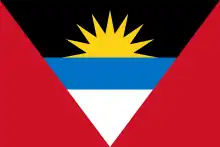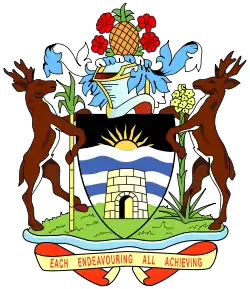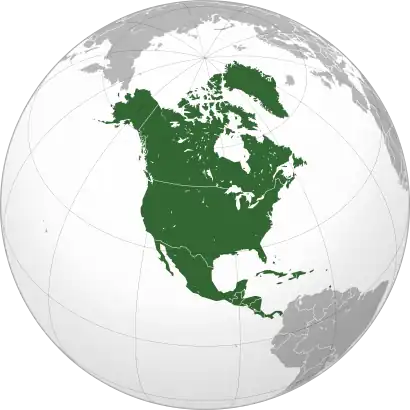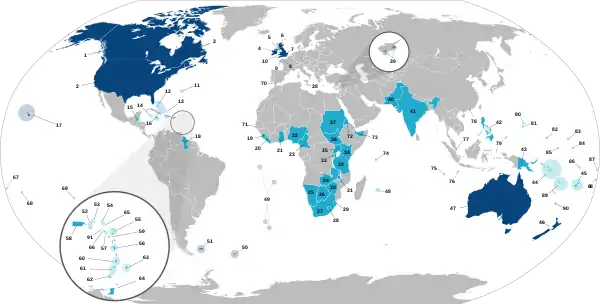Antigua and Barbuda | |
|---|---|
| Motto: "Each Endeavouring, All Achieving" | |
| Anthem: "Fair Antigua, We Salute Thee" | |
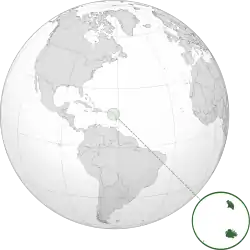 | |
| Capital and largest city | St. John's 17°7′N 61°51′W / 17.117°N 61.850°W |
| Vernacular language | Antiguan and Barbudan Creole |
| Working language | English[1] |
| Ethnic groups (2022[2]) |
|
| Religion (2020[3]) |
|
| Demonym(s) | Antiguan and Barbudan Antiguan Barbudan |
| Government | Unitary parliamentary constitutional monarchy |
• Monarch | Charles III |
| Sir Rodney Williams | |
| Gaston Browne | |
| Legislature | Parliament |
| Senate | |
| House of Representatives | |
| Formation | |
• Union | 23 September 1859[4] |
• Annexation of Redonda | 26 March 1872 |
• Parish Boundaries Act | 17 December 1873[5] |
| 27 February 1967 | |
• Independence | 1 November 1981 |
| Area | |
• Total | 440 km2 (170 sq mi) (182nd) |
• Water (%) | negligible |
| Population | |
• 2022 estimate | 100,772[6] (182nd) |
• 2011 census | 84,816 |
• Density | 186/km2 (481.7/sq mi) |
| GDP (PPP) | 2023 estimate |
• Total | |
• Per capita | |
| GDP (nominal) | 2023 estimate |
• Total | |
• Per capita | |
| Gini | high |
| HDI (2019) | high · 78th |
| Currency | East Caribbean dollar (XCD) |
| Time zone | UTC-4 (AST) |
| Driving side | left |
| Calling code | +1-268 |
| ISO 3166 code | AG |
| Internet TLD | .ag |
Website ab | |
Antigua and Barbuda (UK: /ænˈtiːɡə ... bɑːrˈbuːdə/, US: /ænˈtiːɡwə ... bɑːrˈbjuːdə/) is a sovereign island country in the Caribbean. It lies at the conjuncture of the Caribbean Sea and the Atlantic Ocean in the Leeward Islands part of the Lesser Antilles.
The country consists of two major islands, Antigua and Barbuda, which are approximately 40 km (25 mi) apart, and several smaller islands, including Great Bird, Green, Guiana, Long, Maiden, Prickly Pear, York, and Redonda. The permanent population is approximately 97,120 (2019 estimates), with 97% residing in Antigua.[12] St. John's, Antigua, is the country's capital, major city, and largest port. Codrington is Barbuda's largest town.
In 1493, Christopher Columbus surveyed the island of Antigua, which he named for the Church of Santa María La Antigua.[13] Great Britain colonized Antigua in 1632 and Barbuda in 1678.[13] A part of the Federal Colony of the Leeward Islands from 1871, Antigua and Barbuda joined the West Indies Federation in 1958.[14] With the breakup of the federation in 1962, it became one of the West Indies Associated States in 1967.[15] Following a period of internal self-governance, it gained full independence from the United Kingdom on 1 November 1981. Antigua and Barbuda is a member of the Commonwealth and a Commonwealth realm; it is a constitutional monarchy with Charles III as its head of state.[16]
The economy of Antigua and Barbuda is largely dependent on tourism, which accounts for 80% of its GDP. Like other island nations, Antigua and Barbuda is vulnerable to the effects of climate change, such as sea level rise, and increased intensity of extreme weather like hurricanes. These cause coastal erosion, water scarcity, and other challenges.[17]
Antigua and Barbuda offers a citizenship by investment program.[18] The country levies no personal income tax.[19]
Etymology
Antigua is Spanish for 'ancient' and barbuda is Spanish for 'bearded'.[12] The island of Antigua was originally called Wadadli by the Arawaks and is locally known by that name today; the Caribs possibly called Barbuda Wa'omoni. Christopher Columbus, while sailing by in 1493, may have named it Santa Maria la Antigua, after an icon in the Spanish Seville Cathedral. The "bearded" of Barbuda is thought to refer either to the male inhabitants of the island, or the bearded fig trees present there.[20]
History
Pre-colonial period
Antigua was first settled by archaic age hunter-gatherer Native Americans called the Ciboney.[12][21][22] Carbon dating has established the earliest settlements started around 3100 BC.[23] They were succeeded by the ceramic age pre-Columbian Arawak-speaking Saladoid people who migrated from the lower Orinoco River.[24] They introduced agriculture, raising, among other crops, the famous Antigua Black Pineapple (Ananas comosus), corn, sweet potatoes, chiles, guava, tobacco, and cotton.[25] Later on the more bellicose Caribs also settled the island, possibly by force.
%252C_plate_V_-_BL.jpg.webp)
European arrival and settlement
Christopher Columbus was the first European to sight the islands in 1493.[21][22] The Spanish did not colonise Antigua until after a combination of European and African diseases, malnutrition, and slavery eventually extirpated most of the native population; smallpox was probably the greatest killer.[26]
The English settled on Antigua in 1632;[22][21] Christopher Codrington settled on Barbuda in 1685.[22][21] Tobacco and then sugar was grown, worked by a large population of slaves transported from West Africa, who soon came to vastly outnumber the European settlers.[21]
Colonial era
The English maintained control of the islands, repulsing an attempted French attack in 1666.[21] The brutal conditions endured by the slaves led to revolts in 1701 and 1729 and a planned revolt in 1736, the last led by Prince Klaas, though it was discovered before it began and the ringleaders were executed.[27] Slavery was abolished in the British Empire in 1833, affecting the economy.[22][21] This was exacerbated by natural disasters such as the 1843 earthquake and the 1847 hurricane.[21] Mining occurred on the isle of Redonda, however, this ceased in 1929 and the island has since remained uninhabited.[28]
Part of the Leeward Islands colony, Antigua and Barbuda became part of the short-lived West Indies Federation from 1958 to 1962.[22][21] Antigua and Barbuda subsequently became an associated state of the United Kingdom with full internal autonomy on 27 February 1967.[21] The 1970s were dominated by discussions as to the islands' future and the rivalry between Vere Bird of the Antigua and Barbuda Labour Party (ABLP) (Premier from 1967 to 1971 and 1976 to 1981) and the Progressive Labour Movement (PLM) of George Walter (Premier 1971–1976). Eventually, Antigua and Barbuda gained full independence on 1 November 1981; Vere Bird became prime minister of the new country.[21] The country opted to remain within the Commonwealth, retaining Queen Elizabeth as head of state, with the first governor, Sir Wilfred Jacobs, as governor-general. Succeeding Sir Wilfred Jacobs were Sir James Carlisle (June 10, 1993–June 30, 2007), Dame Louise Lake-Tack (July 17, 2007—August 14, 2014.), and the present governor, Sir Rodney Williams: (August 14, 2014-present).

Independence era
The first two decades of Antigua's independence were dominated politically by the Bird family and the ABLP, with Vere Bird ruling from 1981 to 1994, followed by his son Lester Bird from 1994 to 2004.[21] Though providing a degree of political stability, and boosting tourism to the country, the Bird governments were frequently accused of corruption, cronyism and financial malfeasance.[22][21] Vere Bird Jr., the elder son, was forced to leave the cabinet in 1990 following a scandal in which he was accused of smuggling Israeli weapons to Colombian drug-traffickers.[29][30][22] Another son, Ivor Bird, was convicted of selling cocaine in 1995.[31][32]
In 1995, Hurricane Luis caused severe damage on Barbuda.[33]
The ABLP's dominance of Antiguan politics ended with the 2004 Antiguan general election, which was won by Winston Baldwin Spencer's United Progressive Party (UPP).[21] Winston Baldwin Spencer was Prime Minister of Antigua and Barbuda from 2004 to 2014.[34] However the UPP lost the 2014 Antiguan general election, with the ABLP returning to power under Gaston Browne.[35] ABLP won 15 of the 17 seats in the 2018 snap election under the leadership of incumbent Prime Minister Gaston Browne.[36]
In 2016, Nelson's Dockyard was designated as a UNESCO World Heritage Site.[37]
Most of Barbuda was devastated in early September 2017 by Hurricane Irma, which brought winds with speeds reaching 295 km/h (185 mph). The storm damaged or destroyed 95% of the island's buildings and infrastructure, leaving Barbuda "barely habitable" according to Prime Minister Gaston Browne. Nearly everyone on the island was evacuated to Antigua.[38] Amidst the following rebuilding efforts on Barbuda that were estimated to cost at least $100 million,[39] the government announced plans to revoke a century-old law of communal land ownership by allowing residents to buy land; a move that has been criticised as promoting "disaster capitalism".[40]
Geography
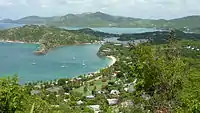 English Harbour
English Harbour Southern coast at sunset
Southern coast at sunset
Limestone formations, rather than volcanic activity, have had the most impact on the topography of both Antigua and Barbuda, which are both relatively low-lying islands. Boggy Peak, also known as Mt. Obama from 2008 to 2016, is the highest point on both Antigua and Barbuda. It is the remnant of a volcanic crater and rises a total of 402 meters. Boggy Peak is located in the southwest of Antigua (1,319 feet).[12][21]
Both of these islands have very irregularly shaped coastlines that are dotted with beaches, lagoons, and natural harbors. There are reefs and shoals that surround the islands on all sides. Because of the low amount of rainfall, there are not many streams. On neither of these islands can sufficient quantities of fresh groundwater be found.[12]
Redonda is a small, uninhabited island located about 40 kilometers (25 miles) to the south-west of Antigua. Redonda is a rocky island.[21]
Cities and villages
The most populous cities in Antigua and Barbuda are mostly on Antigua, being Saint John's, All Saints, Piggotts, and Liberta.[41] The most populous city on Barbuda is Codrington. It is estimated that 25% of the population lives in an urban area, which is much lower than the international average of 55%.[42][43]
Islands
Antigua and Barbuda consists mostly of its two namesake islands, Antigua, and Barbuda. Other than that, Antigua and Barbuda's biggest islands are Guiana Island and Long Island off the coast of Antigua, and Redonda island, which is far from both of the main islands.
Climate
Rainfall averages 990 mm (39 in) per year, with the amount varying widely from season to season. In general the wettest period is between September and November. The islands generally experience low humidity and recurrent droughts. Temperatures average 27 °C (80.6 °F), with a range from 23 °C (73.4 °F) to 29 °C (84.2 °F) in the winter to from 25 °C (77.0 °F) to 30 °C (86.0 °F) in the summer and autumn. The coolest period is between December and February.
Hurricanes strike on an average of once a year, including the powerful Category 5 Hurricane Irma, on 6 September 2017, which damaged 95% of the structures on Barbuda.[44] Some 1,800 people were evacuated to Antigua.[45]
An estimate published by Time indicated that over $100 million would be required to rebuild homes and infrastructure. Philmore Mullin, Director of Barbuda's National Office of Disaster Services, said that "all critical infrastructure and utilities are non-existent – food supply, medicine, shelter, electricity, water, communications, waste management". He summarised the situation as follows: "Public utilities need to be rebuilt in their entirety... It is optimistic to think anything can be rebuilt in six months ... In my 25 years in disaster management, I have never seen something like this."[46]
Environmental issues
Like other island nations, Antigua and Barbuda faces unique environmental issues created by its proximity to the ocean, and small size. These include pressures on water resources, natural ecosystems, and deforestation more generally.
Existing issues on the island are further made worse by climate change, where, unlike other island nations affected by climate change, sea level rise, increased weather variability, create increased pressures on the communities on the islands and the land, through processes like coastal erosion and saltwater intrusion.[47]
Not only do these issues threaten the residents of the island, but also interfere with the economy – where tourism is 80% of the GDP.[48] The 2017 hurricane season was particularly destructive, with Hurricane Maria and Hurricane Irma, repeatedly damaging vulnerable infrastructure on the islands of Antigua and Barbuda.[49]Demographics

Ethnic groups
Antigua has a population of 93,219,[50][51] mostly made up of people of West African, British, and Portuguese descent. The ethnic distribution consists of 91% Black, 4.4% mixed race, 1.7% White, and 2.9% other (primarily East Indian). Most Whites are of British descent. Christian Levantine Arabs and a small number of East Asians and Sephardic Jews make up the remainder of the population.
An increasingly large percentage of the population lives abroad, most notably in the United Kingdom (Antiguan Britons), the United States and Canada. A minority of Antiguan residents are immigrants from other countries, particularly from Dominica, Guyana and Jamaica, and, increasingly, from the Dominican Republic, St. Vincent and the Grenadines and Nigeria. An estimated 4,500 American citizens also make their home in Antigua and Barbuda, making their numbers one of the largest American populations in the English-speaking Eastern Caribbean.[52] 68.47% of the population was born in Antigua and Barbuda.[53]
Languages
The language most commonly used in business is English. There is a noticeable distinction between the Antiguan accent and the Barbudan one.
When compared to Antiguan Creole, Standard English was the language of choice in the years leading up to Antigua and Barbuda's attainment of their independence. The Antiguan Creole language is looked down upon by the upper and middle classes in general. The Antiguan Creole language is discouraged from use in the educational system, and instruction is carried out in Standard (British) English instead.
A significant number of the words that are utilized in the Antiguan dialect are derived from both the British and African languages. This is readily apparent in phrases such as "Innit?" which literally translates to "Isn't it?" Many common island proverbs can be traced back to Africa, such as the pidgin language.
Approximately 10,000 people are able to speak in Spanish.[54]
Religion
 St. John's Cathedral, St. John's
St. John's Cathedral, St. John's%252C_Baxter_Memorial_Methodist_Church.jpg.webp) Baxter Memorial Methodist Church, St.Paul Parish
Baxter Memorial Methodist Church, St.Paul Parish
A majority (77%)[12] of Antiguans are Christians, with the Anglicans (17.6%) being the largest single denomination. Other Christian denominations present are Seventh-day Adventist Church (12.4%), Pentecostalism (12.2%), Moravian Church (8.3%), Roman Catholics (8.2%), Methodist Church (5.6%), Wesleyan Holiness Church (4.5%), Church of God (4.1%), Baptists (3.6%),[55] Mormonism (<1.0%), as well as Jehovah's Witnesses.
Governance
Political system

The politics of Antigua and Barbuda take place within a framework of a unitary, parliamentary, representative democratic monarchy, in which the head of state is the monarch who appoints the governor-general as vice-regal representative.[56] Charles III is the present King of Antigua and Barbuda, having served in that position since the death of his mother, Elizabeth II. She had been the queen since the islands' independence from the United Kingdom in 1981. The King is currently represented by Governor-General Sir Rodney Williams. A council of ministers is appointed by the governor-general on the advice of the prime minister, currently Gaston Browne (2014–).[55] The prime minister is the head of government.[57]
Executive power is exercised by the government while legislative power is vested in both the government and the two chambers of Parliament. The bicameral Parliament consists of the Senate (17 members appointed by members of the government and the opposition party, and approved by the governor-general), and the House of Representatives (17 members elected by first past the post) to serve five-year terms.
The current Leader of His Majesty's Loyal Opposition is Jamale Pringle.
There has been recent development in the republicanism movement in Antigua and Barbuda, following Barbados becoming a republic in 2021 and following the death of Elizabeth II in 2022, with an opinion poll showing majority support for the change.[58][59][60]
Elections
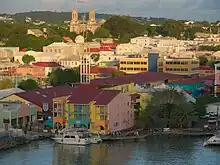
The last election was held on 21 March 2018. The Antigua Barbuda Labour Party (ABLP) led by Prime Minister Gaston Browne won 15 of the 17 seats in the House of Representatives.[61] The previous election was on 12 June 2014, during which the Antigua Labour Party won 14 seats, and the United Progressive Party 3 seats.[62]
Since 1951, elections have been won by the populist Antigua Labour Party. However, in the Antigua and Barbuda legislative election of 2004 saw the defeat of the longest-serving elected government in the Caribbean.[63]
Vere Bird was prime minister from 1981 to 1994 and chief minister of Antigua from 1960 to 1981, except for the 1971–1976 period when the Progressive Labour Movement (PLM) defeated his party. Bird, the nation's first prime minister, is credited with having brought Antigua and Barbuda and the Caribbean into a new era of independence. Prime Minister Lester Bryant Bird succeeded the elder Bird in 1994.
Party elections
Gaston Browne defeated his predecessor Lester Bryant Bird at the Antigua Labour Party's biennial convention in November 2012 held to elect a political leader and other officers.[64] The party then altered its name from the Antigua Labour Party (ALP) to the Antigua and Barbuda Labour Party (ABLP). This was done to officially include the party's presence on the sister island of Barbuda in its organisation, the only political party on the mainland to have a physical branch in Barbuda.
Judiciary
The Eastern Caribbean Supreme Court is the highest court in the region's judicial system (based in Saint Lucia; one judge of the Supreme Court is a resident of the islands and presides over the High Court of Justice). The Caribbean Court of Justice counts Antigua as one of its member states. Its highest court of appeal is the Judicial Committee of the Privy Council, which acts in that capacity.[65]
Foreign relations
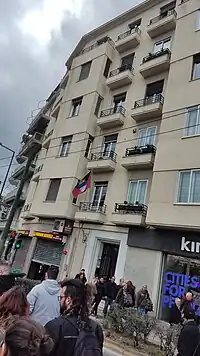
Antigua and Barbuda is a member of the United Nations, the Bolivarian Alliance for the Americas, the Commonwealth of Nations, the Caribbean Community, the Organization of Eastern Caribbean States, the Organization of American States, the World Trade Organization and the Eastern Caribbean's Regional Security System.
Antigua and Barbuda is also a member of the International Criminal Court (with a Bilateral Immunity Agreement of Protection for the US military as covered under Article 98 of the Rome Statute).[66]
In 2013, Antigua and Barbuda called for reparations for slavery at the United Nations. Prime Minister Baldwin Spencer said "We have recently seen a number of leaders apologising", and that they should now "match their words with concrete and material benefits."[67]
Military
About 260 people are currently serving in the Antigua and Barbuda Defense Force in a variety of capacities. These personnel are distributed across the line infantry regiment, the service and support unit, the air force, and the coast guard. In addition there is the Antigua and Barbuda Cadet Corps, which is made up of two hundred young people between the ages of 12 and 18. The Defence Board is in charge of directing the activities of the armed forces of the nation. The National Security Council and the Financial Intelligence Unit are the two intelligence agencies that Antigua and Barbuda have at their disposal. Camp Blizzard serves as the administrative center for the Defense Force.
In 2018, Antigua and Barbuda signed the UN treaty on the Prohibition of Nuclear Weapons.[68]
Administrative divisions
Antigua and Barbuda is divided into six parishes and two dependencies:[55]
|
|
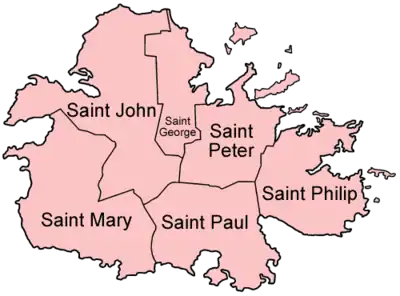
Although they are referred to as dependencies, both Barbuda and Redonda are actually integral parts of the state and can be thought of as administrative divisions. Simply put, "dependency" is just a title. The Redonda is a second-level administrative division that is part of the Saint John Parish's District "A." Barbuda is a local administrative division on the same level as Antigua and Barbuda, and its council is the name of its local governing body. In the year 2023, there have been discussions regarding the possibility of extending governmental authority to Antigua's parishes.
There are currently sixty of what are known as major divisions on the islands of Antigua and Barbuda. This administrative tier is known as the second level.
Local government in the country of Antigua and Barbuda is only present on the island of Barbuda at the present time; however, there is legislation in place for a system of village councils on the island of Antigua; however, village councils have not been active since the 1940s and 1950s.
Human rights
As of July 2022, Same-sex sexual activity is legal in Antigua and Barbuda.[69][70]
Economy
%252C_marina_by_evening.jpg.webp) Antigua is a high end travel destination, as seen here in the marina of English Harbour . . .
Antigua is a high end travel destination, as seen here in the marina of English Harbour . . .%252C_modest_houses.jpg.webp) . . . but poverty is never far away.
. . . but poverty is never far away.
Tourism dominates the economy, accounting for more than half of the gross domestic product (GDP).[12][21] As a destination for the most affluent travelers, Antigua is well known for its extensive collection of five-star resorts. However, weaker tourist activity in lower and middle market segments since the beginning of the year 2000 has slowed the economy and put the government into a tight fiscal corner.[12] Antigua and Barbuda has enacted policies to attract high-net-worth citizens and residents, such as enacting a 0% personal income tax rate in 2019.[19]
The provision of investment banking and financial services also constitutes a significant portion of the economy. Major international financial institutions such as the Royal Bank of Canada (RBC) and Scotiabank both maintain offices in Antigua. PriceWaterhouseCoopers, Pannell Kerr Forster, and KPMG are some of the other companies in the financial services industry that have offices in Antigua.[71] The United States Securities and Exchange Commission has leveled allegations against the Antigua-based Stanford International Bank, which is owned by the Texas billionaire Allen Stanford, of orchestrating a massive fraud that may have resulted in the theft of approximately $8 billion from investors.[72]
The nation, which consists of two islands, directs the majority of its agricultural production toward the markets that are found within the nation. This is done despite the fact that the nation has a limited water supply and a shortage of laborers as a result of the higher wages offered in the tourism and construction industries.[55]
Manufacturing comprises 2% of GDP and is made up of enclave-type assembly for export, the major products being bedding, handicrafts, and electronic components.[73] Prospects for economic growth in the medium term will continue to depend on income growth in the industrialised world, especially in the United States,[55] from which about one-third to one-half of all tourists come.[74]
Access to biocapacity is lower than world average. In 2016, Antigua and Barbuda had 0.8 global hectares[75] of biocapacity per person within its territory, much less than the world average of 1.6 global hectares per person.[76] In 2016, Antigua and Barbuda used 4.3 global hectares of biocapacity per person – their ecological footprint of consumption. This means they use more biocapacity than Antigua and Barbuda contains. As a result, Antigua and Barbuda are running a biocapacity deficit.[75]
The Citizenship by Investment Unit (CIU) is the government authority responsible for processing all applications for Agent's Licenses as well as all applications for Citizenship by Investment made by applicants and their family members. This unit was established by the Prime Minister and is known as the Citizenship by Investment Unit.[77]
Transport
The transportation networks of Antigua and Barbuda are made up of both publicly operated and privately managed services. The roads in the countryside are paved, and their paths are winding and gradual in their ascents and descents; they connect parishes to villages and communities. Cars are driven on the left side of the road. Antigua and Barbuda has a speed limit of 40 miles per hour, and there are traffic signs posted along the main roads that make it easier to commute. Additionally, GPS coordinates have been posted throughout the country, which has made the process of navigation more manageable.
On the yellow license plates of public transportation vehicles, the letters "BUS" indicate that the vehicle is a bus, and the letters "TX" indicate that the vehicle is a taxi. Taxi services are subject to government regulation, which results in the establishment of flat rates rather than the use of meters. It is required that taxi drivers keep a copy of the rates posted inside the cab at all times. Taxis are not hard to come by on Antigua; in particular, you can find them at the airport and in the major hotels. The role of tour guide is one that is frequently taken on by taxi drivers.
On the island of Antigua, buses run continuously throughout the day from 5:30 a.m. until 6:00 p.m., connecting the capital city of St. John's with a number of the surrounding villages. On the other hand, buses do not make stops at the airport or in the tourist area to the north. Although the timing of the bus' departure is frequently up to the discretion of the driver, most buses operate according to a predetermined schedule. The routes that most buses take are typically displayed in the front windows of the vehicles, which are typically private minivans with seating for approximately 15 passengers each. Both the East Bus Station on Independence Avenue close to the Botanical Gardens and the Market Street Bus Station close to the Central Market are the two bus stations that serve the city of St. John's. There are also a number of bus companies operating on the island of Barbuda.
Education
Education in Antigua and Barbuda is compulsory and free for children between the ages of 5 and 16 years.[78] The system is modeled on the British educational system. The current Minister of Education, Sport & Creative Industries is Daryll Sylvester Matthew.[79]
The adult literacy rate in Antigua and Barbuda is approximately 99%.[80][81]

Culture
The culture is primarily influenced by the traditions of West Africa as well as those of the United Kingdom.
The most popular sport in the country is cricket. Football, boat racing, and surfing are three additional popular forms of athletic competition. (Antigua Sailing Week attracts locals and visitors from all over the world).
Music
Since the majority of Antiguans and Barbudans are descended from West Africans who were brought to the islands as slaves by Europeans, the musical traditions of Antigua and Barbuda are predominately of African origin and have only been marginally influenced by European musical traditions.
The island nation of Antigua and Barbuda can be found in the Caribbean's Lesser Antilles chain of islands. It is a second home for many of the popular music genres that are popular throughout the Caribbean, including calypso, soca, steeldrum, zouk, and reggae, and it has produced stars in these genres. Steeldrum and calypso are two musical styles that were brought to Antigua from Trinidad and Tobago, and they are the two that have had the most significant impact on the development of modern Antiguan popular music.
Other than this, very little to no research has been done on the musical history of Antigua and Barbuda. Consequently, a significant amount of the knowledge on the subject comes from novels, essays, and other types of secondary sources.
Festivals
Although on some islands Carnival may be used to celebrate the beginning of Lent, the national Carnival held every August is held to commemorate the abolition of slavery in the British West Indies. The national Carnival is held in August. The festive pageants, shows, and competitions, along with the other events that take place, are a major draw for tourists.
Cuisine
Antigua and Barbuda cuisine is a term used to describe the culinary traditions of the islands of Antigua and Barbuda in the Caribbean. Fungie, pronounced "foon-jee", and pepperpot are the country's official dish and dish of pride. Cornmeal is the main ingredient in fungie, which is a dish that is very similar to the Italian dish polenta. Other popular dishes from this region include ducana, saltfish, seasoned rice, and lobster (from Barbuda). In addition, there are sweets that are made locally, such as peanut brittle, sugar cake, fudge, raspberry and tamarind stew, and other similar dishes.[82]
Despite the fact that these foods are native to Antigua and Barbuda as well as to a number of other Caribbean nations, the diet of the locals has become increasingly diverse and now also includes traditional dishes from Jamaica and Trinidad, such as jerk meats and roti, as well as specialties from a number of other Caribbean nations.
Saltfish, eggs, eggplant (also referred to as troba), lettuce, and other vegetables are typically served for breakfast. Lunches typically consist of a starch, such as rice, macaroni, or pasta, with vegetables or salad, an entree (such as fish, chicken, pork, or beef), and a side dish, such as macaroni pie, scalloped potatoes, or plantains. Dinners typically consist of a protein, such as fish, chicken, pork, or beef. On Sundays, the majority of people in the country attend religious services, and then they return home to prepare a wide variety of meals for their families. Due to the fact that most people are off work on Sundays, dinner is typically served earlier in the day (around 2:00 pm). Dinners might consist of pork, chicken baked in the oven, stewed lamb, or turkey, served with rice (prepared in a variety of ways), macaroni pie, salads, and a local beverage. Dessert options include ice cream and cake, apple pie (or mango or pineapple pie when those fruits are in season), gelatin, and cake. The soft, buttery loaf of bread known as Antiguan butter bread does not require any additional butter to be added once it has been baked. This dish is another mainstay of Antiguan cuisine. Breakfast and other meals throughout the day often consist of fresh-baked butter bread and cheese for the community's residents. Throughout the city of Antigua, there are a great number of homes that have small bakeries built onto them. These bakeries sell freshly baked loaves, and locals can go to these bakeries to buy them. They are served alongside cheese, sardines, and/or a bright red sausage that residents of the area occasionally refer to as salami, in addition to a great deal of other foods. In addition, the majority of meals feature something known as "provisions", which is typically a root vegetable or starch such as potatoes, yams, sweet potatoes, or eddo. During Carnival, a popular snack is souse, which is a type of soup that is very spicy and is made with pig feet, knuckles, and tails in addition to many onions. This soup is sold by vendors on the side of the road. Black pudding, also referred to as blood sausage, is a well-seasoned sausage that is made with rice, meat, and blood that is also enjoyed by locals in Antigua. On improvised grills, locals in the countryside sell freshly picked corn that has been roasted, typically while still in the husk. The Antiguan pineapple is typically quite succulent and sugary, despite its diminutive size. The entire island is covered with numerous small pineapple plantations.
The following are some examples of local beverages: mauby, seamoss, tamarind juice, raspberry juice, mango juice, lemonade, coconut milk, hibiscus juice, ginger beer, passion fruit juice, guava juice, soursop juice, and ginger beer, which is a soft drink. Beer, malts, and rums are some of the alcoholic beverages that can be found here. Many of these drinks are produced locally, such as the award-winning English Harbour Rum and the Wadadli beer, which takes its name from the island's former name. A significant number of residents in the area consume bottled sodas, which they refer to as sweet drink. Punch is a flavor that is enjoyed by many. In addition to Red Stripe beer, Guinness stout, Heineken beer, and Malta, the locals like to drink Red Malta. Ponche Kuba Cream Liqueur is a special celebratory alcoholic drink that is very popular in Antigua during the Christmas holiday season. This beverage has a brown color, has a thick and creamy consistency, is extremely sweet, and contains a high percentage of alcohol.
Media
The Antigua Daily Observer, the Antigua News Room, and The Antiguan Times are the names of the country's three newspapers. The Antigua Observer is the only newspaper that is published every day in printed form.
It is possible to watch the local television channel, ABS TV 10. (it is the only station that shows exclusively local programs). There are also a number of radio stations that broadcast regionally and locally. Some of these stations include V2C-AM 620, ZDK-AM 1100, VYBZ-FM 92.9, ZDK-FM 97.1, Observer Radio 91.1 FM, DNECA Radio 90.1 FM, Second Advent Radio 101.5 FM, Abundant Life Radio 103.9 FM, Crusader Radio 107.3 FM, Nice FM 104.3, Pointe FM 99.1, and WTP 93.5FM.
Monuments
- Fort James, an 18th century fort at the eastern entrance to St. John's harbour
- Fort Barrington, an 18th century fort at the western entrance to St. John's harbour
- Shirley Heights, grounds of an 18th century military complex overlooking English Harbour
- Fort Berkeley, an 18th century fort at the western entrance to English Harbour
- Fort Charlotte, remains of an 18th century fort at the eastern entrance to English Harbour
Museums
World heritage
In 2016, Antigua Naval Dockyard and Related Archaeological Sites have been inscribed in the UNESCO World Heritage List.[83]
Sports
Cricket is the most popular sport within the islands. With Sir Isaac Vivian Alexander Richards KNH OBE OOC who represented the West Indies cricket team between 1974 and 1991, Antigua had one of the world's most famous batsmen ever.[84][85] The Antigua and Barbuda national cricket team represented the country at the 1998 Commonwealth Games, but Antiguan cricketers otherwise play for the Leeward Islands cricket team in domestic matches and the West Indies cricket team internationally. The 2007 Cricket World Cup was hosted in the West Indies from 11 March to 28 April 2007. Antigua hosted eight matches at the Sir Vivian Richards Stadium, which was completed on 11 February 2007 and can hold up to 20,000 people.
Antigua is a Host of Stanford Twenty20 – Twenty20 Cricket, a version started by Allen Stanford in 2006 as a regional cricket game with almost all Caribbean islands taking part. From 15 January to 5 February 2022, the Sir Vivian Richards Stadium was one of the venues for the 2022 ICC Under-19 Cricket World Cup.
Rugby and Netball are popular as well.
Association football, or soccer, is also a very popular sport. Antigua has a national football team which entered World Cup qualification for the 1974 tournament for 1986 and beyond. A professional team was formed in 2011, Antigua Barracuda FC, which played in the USL Pro, a lower professional league in the US. The nation's team had a major achievement in 2012, getting out of its preliminary group for the 2014 World Cup, notably due to a victory over powerful Haiti. In its first game in the next CONCACAF group play on 8 June 2012 in Tampa, FL, Antigua and Barbuda, comprising 17 Barracuda players and 7 from the lower English professional leagues, scored a goal against the United States. However, the team lost 3:1 to the US.
Daniel Bailey had become the first Antiguan to reach a world indoor final, where he won a bronze medal at the 2010 IAAF World Indoor Championships. He was also the first Antiguan to make a 100m final at the 2009 World Championships in Athletics, and the first Antiguan to run under 10 seconds over 100m.[86]
Brendan Christian won a gold medal in the 200m and a bronze medal in the 100m at the 2007 Pan American Games.[87] James Grayman won a bronze medal at the same games in the men's High Jump.[88]
Miguel Francis is the first Antiguan to run sub 20 seconds in the 200m.[89]
Heather Samuel won a bronze medal at the 1995 Pan American Games over 100m.[90]
400m Hurdles Olympian Gold Medalist Rai Benjamin previously represented Antigua and Barbuda before representing the United States. His Silver medal run at the 2020 Olympic Games made him the second-fastest person in history over 400m Hurdles with a time of 46.17.[91]
Notable people
Symbols
The frigatebird is the country's official national bird, and the bucida buceras is the official national tree (Whitewood tree).[92]
Clare Waight Keller designed Meghan Markle's wedding veil, which featured the distinctive flora of each Commonwealth nation. To represent Antigua and Barbuda, Agave karatto was included in the veil by Clare Waight Keller.[93]
The European fallow deer, or Dama dama, is the country's official mammal, despite the fact that it is a non-native species.[94]: 16
In 1992, the government held a contest to design a new national dress for the country, and the winner of the competition was the artist Heather Doram.[94][95]
See also
References
- ↑ "Government of Antigua and Barbuda". Archived from the original on 3 May 2022. Retrieved 23 March 2022.
- ↑ "ECLAC/CELADE Redatam+SP 03/21/2022" (PDF). redatam.org. Archived from the original (PDF) on 21 March 2022. Retrieved 23 March 2022.
- ↑ "National Profiles".
- ↑ "CHAPTER 43 : THE BARBUDA (EXTENSION OF LAWS OF ANTIGUA) ACT" (PDF). Laws.gov.ag. Archived (PDF) from the original on 8 June 2022. Retrieved 14 April 2022.
- ↑ "Chapter 304: The Parish Boundaries Act". Laws of Antigua and Barbuda (PDF). laws.gov.ag. 17 December 1873. Archived (PDF) from the original on 3 May 2022. Retrieved 14 April 2022.
- ↑ "Population projections by age group, annual 1991 to 2026". Statistics Division, Ministry of Finance and Corporate Governance of Antigua and Barbuda. Archived from the original on 27 June 2022.
- 1 2 "World Economic Outlook October 2023 (Antigua and Barbuda)". International Monetary Fund. October 2023. Retrieved 13 December 2023.
- ↑ Horsford, Ian. "An Assessment of Income Inequality and Poverty in Antigua and Barbuda in 2007". Archived from the original on 18 April 2022. Retrieved 23 March 2022.
- ↑ "Comparison of Poverty measurement indicators" (PDF). Economic Commission for Latin America (ECLA). 2006. Archived (PDF) from the original on 2 May 2021. Retrieved 23 March 2022.
- ↑ Human Development Report 2020 The Next Frontier: Human Development and the Anthropocene (PDF). United Nations Development Programme. 15 December 2020. pp. 343–346. ISBN 978-92-1-126442-5. Archived (PDF) from the original on 15 December 2020. Retrieved 16 December 2020.
- ↑ "Government of Antigua and Barbuda". Archived from the original on 3 May 2022. Retrieved 23 March 2022.
- 1 2 3 4 5 6 7 8 "Antigua and Barbuda". The World Factbook (2024 ed.). Central Intelligence Agency. Retrieved 24 January 2021. (Archived 2021 edition)
- 1 2 Crocker, John. "Barbuda Eyes Statehood and Tourists". The Washington Post. 28 January 1968. p. E11.
- ↑ Fleck, Bryan. "Discover Unspoiled: Barbuda". Everybody's Brooklyn. 31 October 2004. p. 60.
- ↑ Sheridan, Richard B. (1974). Sugar and Slavery: An Economic History of the British West Indies, 1623–1775. Canoe Press. p. 185. ISBN 978-976-8125-13-2. Archived from the original on 24 February 2021. Retrieved 10 November 2018.
- ↑ "Antigua and Barbuda – Countries – Office of the Historian". history.state.gov. Archived from the original on 7 June 2022. Retrieved 11 September 2017.
- ↑ "World Bank Climate Change Knowledge Portal:Antique and Barbuda". World Bank. Archived from the original on 30 January 2021. Retrieved 25 November 2020.
- ↑ "Passport of Antigua and Barbuda | Rank = 23 | Passport Index 2022 | How powerful is yours?". Passport Index – Global Mobility Intelligence. Archived from the original on 31 March 2022. Retrieved 23 April 2022.
- 1 2 "Individual Income Tax Rates Table – KPMG Global". KPMG. 11 November 2020. Archived from the original on 1 May 2021. Retrieved 6 May 2021.
- ↑ IT (3 March 2020). "History Of Antigua – Antigua And Barbuda". Antigua and Barbuda Embassy in Madrid – Ambassador Dario Item. Retrieved 19 July 2022.
- 1 2 3 4 5 6 7 8 9 10 11 12 13 14 15 16 17 Niddrie, David Lawrence; Momsen, Janet D.; Tolson, Richard. "Antigua and Barbuda". Encyclopædia Britannica. Archived from the original on 3 April 2019. Retrieved 8 July 2019.
- 1 2 3 4 5 6 7 8 "Antigua and Barbuda : History". The Commonwealth. Archived from the original on 24 June 2019. Retrieved 8 July 2019.
- ↑ Napolitano, Matthew F.; DiNapoli, Robert J.; Stone, Jessica H.; Levin, Maureece J.; Jew, Nicholas P.; Lane, Brian G.; O'Connor, John T.; Fitzpatrick, Scott M. (18 December 2019). "Reevaluating human colonization of the Caribbean using chronometric hygiene and Bayesian modeling". Science Advances. 5 (12): eaar7806. Bibcode:2019SciA....5R7806N. doi:10.1126/sciadv.aar7806. ISSN 2375-2548. PMC 6957329. PMID 31976370.
- ↑ "Caribbean Trade and Networks (U.S. National Park Service)". nps.gov. Retrieved 19 July 2022.
- ↑ Duval, D. T. (1996). Saladoid archaeology on St. Vincent, West Indies: results of the 1993/1994 University of Manitoba survey
- ↑ Austin Alchon, Suzanne (2003). A pest in the land: new world epidemics in a global perspective. University of New Mexico Press. pp. 62–63. ISBN 0-8263-2871-7. Archived from the original on 29 November 2021. Retrieved 11 September 2020.
- ↑ "Antigua's Disputed Slave Conspiracy of 1736". Archived from the original on 8 July 2019. Retrieved 8 July 2019.
- ↑ Kras, Sara Louise (2008). Antigua and Barbuda. Cultures of the World. Vol. 26. Marshall Cavendish. p. 18. ISBN 9780761425700. Archived from the original on 18 April 2021. Retrieved 11 September 2020.
a cableway using baskets was built to transfer the mined phosphate to a pier for shipping
- ↑ "Antiguan Quits in Weapons Scandal". Sun-Journal. 26 April 1990. Archived from the original on 31 May 2022. Retrieved 4 July 2011.
- ↑ "Antigua-Barbuda: Government Finally Orders Probe of Arms Shipment". IPS-Inter Press Service. 25 April 1990.
- ↑ Massiah, David (7 May 1995). "Younger Brother of Prime Minister Lester Bird Is Arrested on Cocaine Charges". Associated Press Worldstream. Associated Press.
- ↑ Massiah, David (8 May 1995). "Prime Minister Lester Bird Promises No Intervention in Brother's Arrest". Associated Press Worldstream. Associated Press.
- ↑ "20th Anniversary of Hurricane Luis". Anumetservice.wordpress.com. 5 September 2015. Archived from the original on 12 September 2017. Retrieved 30 September 2017.
- ↑ "Caribbean Elections Biography | Winston Baldwin Spencer". www.caribbeanelections.com. Archived from the original on 25 December 2021. Retrieved 29 December 2021.
- ↑ Charles, Jacqueline. "Browne becomes new prime minister of Antigua, youngest ever". The Miami Herald. Archived from the original on 14 July 2014. Retrieved 14 June 2014.
- ↑ "Speculation about early election in Antigua". Barbados Today. 12 June 2021. Archived from the original on 18 December 2021. Retrieved 29 December 2021.
- ↑ "Nelson's Dockyard in Antigua now a Unesco heritage site: Travel Weekly". travelweekly.com.
- ↑ Panzar, Javier; Willsher, Kim (9 September 2017). "Hurricane Irma leaves Caribbean Islands Devastated". Los Angeles Times. Archived from the original on 11 September 2017. Retrieved 11 September 2017.
- ↑ John, Tara (11 September 2017). "Hurricane Irma Flattens Barbuda, Leaving Population Stranded". Time. Archived from the original on 7 August 2020. Retrieved 1 September 2020.
- ↑ Boger, Rebecca; Perdikaris, Sophia (11 February 2019). "After Irma, Disaster Capitalism Threatens Cultural Heritage in Barbuda". NACLA. Archived from the original on 25 December 2021. Retrieved 1 September 2020.
- ↑ "Largest cities in Antigua and Barbuda". Mongabay. Archived from the original on 12 January 2021. Retrieved 3 February 2021.
- ↑ "Urban Population (%of total population)". The World Bank. Archived from the original on 7 November 2017. Retrieved 3 February 2021.
- ↑ "Antigua and Barbuda – Urban Population". Index Mundi. Archived from the original on 18 April 2021. Retrieved 3 February 2021.
- ↑ Hanna, Jason; Sterling, Joe; Almasy, Steve (6 September 2017). "Hurricane Irma: Powerful storm blamed for three deaths". ABS TV Radio Antigua & Barbuda. CNN. Archived from the original on 24 June 2018. Retrieved 6 September 2017.
- ↑ Panzar, Javier (9 September 2017). "Hurricane Irma leaves Caribbean islands devastated". Los Angeles Times. Archived from the original on 11 September 2017. Retrieved 11 September 2017.
- ↑ John, Tara /. "'There Is No Home to Go Back to.' Hurricane Irma Flattens Barbuda, Leaving Population Stranded". Time. Archived from the original on 11 September 2017. Retrieved 11 September 2017.
- ↑ "World Bank Climate Change Knowledge Portal". climateknowledgeportal.worldbank.org. Retrieved 25 November 2020.
- ↑ "Deforestation statistics for Antigua and Barbuda". RainForests Mongabay. Retrieved 24 November 2020.
- ↑ "Vulnerability of Eastern Caribbean Countries - World". ReliefWeb. Retrieved 25 November 2020.
- ↑ "World Population Prospects 2022". population.un.org. United Nations Department of Economic and Social Affairs, Population Division. Retrieved 17 July 2022.
- ↑ "World Population Prospects 2022: Demographic indicators by region, subregion and country, annually for 1950-2100" (XSLX). population.un.org ("Total Population, as of 1 July (thousands)"). United Nations Department of Economic and Social Affairs, Population Division. Retrieved 17 July 2022.
- ↑ "Background Note: Antigua and Barbuda". state.gov. Archived from the original on 22 January 2017. Retrieved 23 August 2007.
- ↑ "ECLAC/CELADE Redatam+SP 11/12/2022" (PDF). redatam.org. Archived from the original (PDF) on 12 November 2022. Retrieved 12 November 2022.
- ↑ Farquhar, Bernadette, "The Spanish Language in Antigua and Barbuda: Implications for Language Planning and Language Research" Archived 15 July 2013 at the Wayback Machine
- 1 2 3 4 5
 This article incorporates text from this source, which is in the public domain: "Antigua and Barbuda". The World Factbook (2024 ed.). Central Intelligence Agency. Retrieved 24 January 2021. (Archived 2021 edition)
This article incorporates text from this source, which is in the public domain: "Antigua and Barbuda". The World Factbook (2024 ed.). Central Intelligence Agency. Retrieved 24 January 2021. (Archived 2021 edition) - ↑ "Antigua and Barbuda 1981". Constitute. Archived from the original on 21 February 2015. Retrieved 20 February 2015.
- ↑ "Antigua and Barbuda Country Profile". caribbeanelections.com. Archived from the original on 28 November 2021. Retrieved 29 December 2021.
- ↑ Fleary, Sinai (6 December 2021). "Antigua and Barbuda the next Caribbean nation to become a republic?". Voice Online. Retrieved 8 May 2023.
- ↑ "Antigua and Barbuda to hold republic referendum within three years, says PM". The Guardian. Press Association. 11 September 2022. ISSN 0261-3077. Retrieved 8 May 2023.
- ↑ "Uncharted Realms: The Future of the Monarchy in the UK and Around the World – Lord Ashcroft Polls". lordashcroftpolls.com. Retrieved 4 May 2023.
- ↑ "Antigua and Barbuda General Election Results 2018". caribbeanelections.com. Archived from the original on 2 April 2018. Retrieved 14 February 2022.
- ↑ "Antigua and Barbuda General Election Results 2014". caribbeanelections.com. Archived from the original on 14 February 2022. Retrieved 14 February 2022.
- ↑ "IFES Election Guide | Elections: Antigua & Barbuda Par Mar 23 2004". www.electionguide.org. Archived from the original on 14 February 2022. Retrieved 14 February 2022.
- ↑ "Gaston Browne Is Antigua's New Opposition Leader | RJR News – Jamaican News Online". Radiojamaicanewsonline.com. 5 December 2012. Archived from the original on 14 February 2022. Retrieved 20 February 2022.
- ↑ "Caribbean Court of Justice". International Justice Resource Center. 5 September 2012. Archived from the original on 29 January 2017. Retrieved 2 March 2017.
- ↑ "Latin American and Caribbean State Parties to the Rome Statute, International Criminal Court. Retrieved 10 July 2021". Archived from the original on 9 August 2021. Retrieved 10 July 2021.
- ↑ "Slavery reparations: Blood money". The Economist. 5 October 2013. Archived from the original on 4 December 2017. Retrieved 27 June 2022.
- ↑ "Chapter XXVI: Disarmament – No. 9 Treaty on the Prohibition of Nuclear Weapons". United Nations Treaty Collection. 7 July 2017. Archived from the original on 6 August 2019. Retrieved 16 August 2019.
- ↑ Avery, Daniel (4 April 2019). "71 Countries Where Homosexuality is illegal". Newsweek. Archived from the original on 11 December 2019. Retrieved 16 August 2019.
- ↑ "State-Sponsored Homophobia". International Lesbian Gay Bisexual Trans and Intersex Association. 20 March 2019. Archived from the original on 8 February 2020. Retrieved 16 August 2019.
- ↑ "Antigua: a Mature Financial Centre". IFC Review. Retrieved 11 October 2022.
- ↑ Krauss, Clifford; Creswell, Julie; Savage, Charlie (21 February 2009). "Fraud Case Shakes a Billionaire's Caribbean Realm". The New York Times. Archived from the original on 16 April 2009. Retrieved 14 April 2010.
- ↑ "Manufacturing, value added (% of GDP) – Antigua and Barbuda, Germany | Data". World Bank. Retrieved 11 October 2022.
- ↑ Newsdesk (15 September 2021). "Antigua and Barbuda's Tourism Growth Continues". Travel Agent Central. Archived from the original on 16 September 2021. Retrieved 24 April 2022.
- 1 2 "Country Trends". Global Footprint Network. Archived from the original on 8 August 2017. Retrieved 4 June 2020.
- ↑ Lin, David; Hanscom, Laurel; Murthy, Adeline; Galli, Alessandro; Evans, Mikel; Neill, Evan; Mancini, MariaSerena; Martindill, Jon; Medouar, FatimeZahra; Huang, Shiyu; Wackernagel, Mathis (2018). "Ecological Footprint Accounting for Countries: Updates and Results of the National Footprint Accounts, 2012–2018". Resources. 7 (3): 58. doi:10.3390/resources7030058.
- ↑ Citizenship by Investment Unit. "Antigua and Barbuda Citizenship by Investment Program". Antigua and Barbuda. Archived from the original on 2 November 2019. Retrieved 2 November 2019.
- ↑ "Antigua and Barbuda" Archived 2008-09-26 at the Wayback Machine. 2001 Findings on the Worst Forms of Child Labor. Bureau of International Labor Affairs, U.S. Department of Labor (2002). This article incorporates text from this source, which is in the public domain.
- ↑ "Meet your Minister - Daryll Matthew". Antigua News. 20 January 2023. Archived from the original on 20 January 2023.
- ↑ "Literacy rate, adult total (% of people ages 15 and above) - Antigua and Barbuda | Data". data.worldbank.org. Retrieved 10 December 2022.
- ↑ "Education Statistics (EdStats): Antigua and Barbuda". The World Bank. 2022. Archived from the original on 2 July 2023.
- ↑ "Antigua & Barbuda National Dish & Recipe". RecipeIsland.com. Archived from the original on 25 August 2011.
- ↑ "Antigua Naval Dockyard and Related Archaeological Sites". UNESCO World Heritage Centre. Retrieved 13 November 2023.
- ↑ "Viv Richards was a complete genius: Imran Khan". Dawn. Pakistan. 2 April 2011. Retrieved 25 January 2021.
- ↑ Featured Columnist (13 November 2013). "The ICC Ranking System's Top 10 Batsmen in ODI Cricket History". Bleacher Report. Retrieved 7 August 2014.
- ↑ "Bailey focused on one task at a time as preparation for world games intensifies". antiguaobserver. Archived from the original on 15 February 2022. Retrieved 14 February 2022.
- ↑ "Antigua and Barbuda's Brendan Christian in the men's 200 metres final at the Pan American Games". Jamaican Gleaner. Archived from the original on 15 February 2022. Retrieved 14 February 2022.
- ↑ "defending champion James Grayman of Antigua & Barbuda and St. Lucia's Darwin Edwards, both with 2.25". stabroeknews.com. Retrieved 14 February 2022.
- ↑ "'It Was Such an Euphoric Moment' Manager Says of Francis' 19.88". trackalerts.com. 21 June 2016. Archived from the original on 15 February 2022. Retrieved 14 February 2022.
- ↑ "Heather Samuel Hall of Fame 2004". goracers.com. Archived from the original on 15 February 2022. Retrieved 14 February 2022.
- ↑ "Rai Benjamin beat a record and still lost in an all-time great Olympic race". Los Angeles Times. Archived from the original on 15 February 2022. Retrieved 15 February 2022.
- ↑ "Government of Antigua and Barbuda". ab.gov.ag. Archived from the original on 13 November 2021. Retrieved 16 April 2020.
- ↑ "The Wedding Dress: Clare Waight Keller for Givenchy". The Royal Household, UK. 19 May 2018. Archived from the original on 19 May 2019. Retrieved 5 March 2019.
- 1 2 Kras, Sara Louise (2008). Antigua and Barbuda. Marshall Cavendish. ISBN 978-0-7614-2570-0. Archived from the original on 31 May 2022. Retrieved 31 May 2022.
- ↑ Gall, Timothy L.; Hobby, Jeneen (2009). Worldmark Encyclopedia of Cultures and Daily Life. Gale. ISBN 978-1-4144-4890-9. Archived from the original on 8 March 2022. Retrieved 1 January 2022.
Works cited
- McDaniel, Lorna (1999). "Antigua and Barbuda". Garland Encyclopedia of World Music. Vol. 2. Routledge. pp. 798–800. ISBN 0-8153-1865-0.
Further reading
- Nicholson, Desmond V., Antigua, Barbuda, and Redonda: A Historical Sketch, St. Johns, Antigua: Antigua and Barbuda Museum, 1991.
- Dyde, Brian, A History of Antigua: The Unsuspected Isle, London: Macmillan Caribbean, 2000.
- Gaspar, David Barry – Bondmen & Rebels: A Study of Master-Slave Relations in Antigua, with Implications for Colonial America.
- Harris, David R. – Plants, Animals, and Man in the Outer Leeward Islands, West Indies. An Ecological Study of Antigua, Barbuda, and Anguilla.
- Henry, Paget – Peripheral Capitalism and Underdevelopment in Antigua.
- Lazarus-Black, Mindie – Legitimate Acts and Illegal Encounters: Law and Society in Antigua and Barbuda.
- Riley, J. H. – Catalogue of a Collection of Birds from Barbuda and Antigua, British West Indies.
- Rouse, Irving and Birgit Faber Morse – Excavations at the Indian Creek Site, Antigua, West Indies.
- Thomas Hearne. Southampton.
External links
- The Official Website of the Government of Antigua and Barbuda
 Wikimedia Atlas of Antigua and Barbuda
Wikimedia Atlas of Antigua and Barbuda- Antigua and Barbuda, United States Library of Congress
- Antigua and Barbuda. The World Factbook. Central Intelligence Agency.
- Antigua and Barbuda from UCB Libraries GovPubs
- Antigua and Barbuda at Curlie
- Antigua and Barbuda from the BBC News
- World Bank's country data profile for Antigua and Barbuda
- ArchaeologyAntigua.org – 2010March13 source of archaeological information for Antigua and Barbuda
- Antigua & Barbuda Official Business Hub
